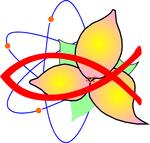The article in Nature stated that the Lithium and Beryllium abundances in the solar atmosphere is another confirmatory evidence that nuclear energy is not responsible for the majority of the energy generation in the Sun."[18]
We know that lithium would be destroyed in around 7,500 years[19] when the central temperature of a young star reaches 3 million degrees.[20]
Observations show that the Sun has already lost all but around one thousandth of its original abundance of Lithium.[21] This implies that if the Sun had the expected initial abundance of Lithium, then its central temperature must, of course, be at least 3 million degrees.
However, the Sun still has its normal abundance of Beryllium which is destroyed at a temperature of 4 million degrees.[22] If the Russian scientists are correct in assuming that the Sun is homogeneous, then this means that the temperature throughout the whole Sun must be far lower than the 15 million degrees required for the Sun to be an old main-sequence star.
RECENT SUPPORTING EVIDENCES
There are a great many confirmatory evidences for a young Sun. One of the most recent was the announcement at a major scientific conference in 1995 that the temperature at the center of the Sun seems to be varying over a period of several months.[23] This is extremely hard to understand if the Sun has a huge central core with a resulting enormous heat capacity. However, such rapid temperature changes are explicable if the Sun is young and homogeneous. In such a situation there can be very rapid convective changes in temperature throughout the entire Sun. (This idea will be developed in a future article.)
CONCLUSION
The three major observational evidences described in this article correlate with the expected characteristics of a young star that is obtaining its energy from gravitational contraction. The Sun simply does not seem to have a large core that is very dense and has the high temperature that can sustain hydrogen nuclear burning. In other words, the Sun definitely does not show the characteristics of a multi billion-year-old star, but instead shows the characteristics of an exceedingly young star.
REFERENCES
[1], [2] Severny, A.B. Kotov, V.A., and Tsap, T.T., 1976. "Observations of solar pulsations," Nature, vol. 259, p 89.
[3] Ibid., p 88.
[4] A typical description of the Sun's core under the 'standard model' is that of Nicolson on p 14 of The Sun published in 1982 by Michael Beazley, in association with the Royal Astronomical Society. Nicolson gives the Sun's core as having a diameter of 350,000 km with a density of 160,000 Kg ^3 (about 14 times the density of lead.) This large core would extend outward to about 1/4 of the solar radius. The temperature of the core would be around 15,000,000 degrees K.
[5] Brookes, J.R., Isaak, G.R., and van der Raay, H.B., 1976. "Observation of free oscillations of the Sun," Nature, vol. 259, p 94. Also Nicolson, 1., 1982. The Sun Publ. Michael Beazley p 84.
[6] Nicolson, op. cit., p 84.
[7] Brookes et al., op. cit., p 94.
[8], [9], [10] Severny op. cit., p 88.
[11], [12] Brookes et al., op. cit., p 94.
[13] Nicolson op. cit., p 84.
[14] Christensen-Dalsgaard, I., and Gough, D.O., 1976. "Towards a heliological inverse problem," Nature vol. 259 p 90.
[15] National Research Council. 1991 The Decade of Discovery in Astronomy and Astrophysics National Academy Press. p 34.
[16] Karttunen, H., Kroger, P., Oja, H., Poutanen, M., Donner, K.J., 1987.Fundamental Astronomy Springer-Verlag p 273.
[17] Nicolson op. cit., p 84.
[18] Severny, op. cit., p 89.
[19] Hopkins, J., 1980. Glossary of Astronomy and Astrophysics. University of Chicago Press p 102.
[20] Karttunen op. cit., p 273.
[21] Stephens, S., "Needles in the Cosmic Haystack" Astronomy September 1995 p 53
[22] Karttunen op. cit., p 273.
[23] Chown, M., "The riddle of the solar wind," New Scientist 12th August, 1995, p 16.
Keith is an accomplished theoretical astronomer who has studied celestial mechanics for many years. His understanding of this area brings great light on many creation based perspectives of the universe.
Institute for Creation Research, PO Box 2667, El Cajon, CA 92021
Voice: (619) 448-0900 FAX: (619) 448-3469
"Vital Articles on Science/Creation" June 1996
Copyright © 1996 All Rights Reserved
This "Impact" was converted to HTML, for Web use, from the original formatted desktop article. Comments regarding typographical errors in the above material are appreciated. Don Barber, ICR Systems Administrator Fax: (619) 448-3469
All ICR staff members adhere to a Statement of Faith in the form of two documents: "Tenets of Scientific Creationism," and "Tenets of Biblical Creationism." (see Impact No. 85)
As a missionary organization, ICR is funded by God's people. The majority of its income is provided by individual donors who desire to proclaim God's truth about origins. Gifts can be designated for research, the graduate school, seminars, or any special part of the ICR ministry. All others will be used where most needed. We pledge to use them wisely and with integrity.If you would like to receive our free monthly newsletter "Acts & Facts," or our free quarterly devotional Bible-study booklet "Days of Praise," just request them by contacting ICR at (619) 448-0900.
We believe God has raised up ICR to spearhead Biblical Christianity's defense against the godless dogma of evolutionary humanism. Only by showing the scientific bankruptcy of evolution, while exalting Christ and the Bible, will Christians be successful in "the pulling down of strongholds; casting down imaginations, and every high thing that exalteth itself against the knowledge of God, and bringing into captivity every thought to the obedience of Christ" (II Corinthians10:4,5).
Member, Evangelical Council for Financial Accountability
***





